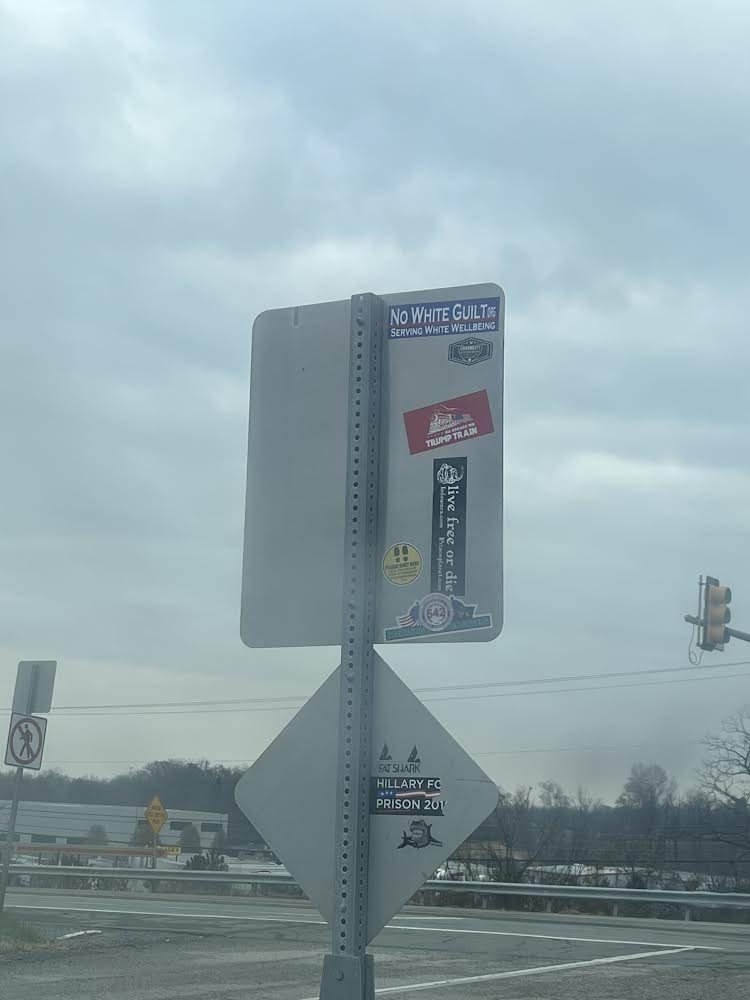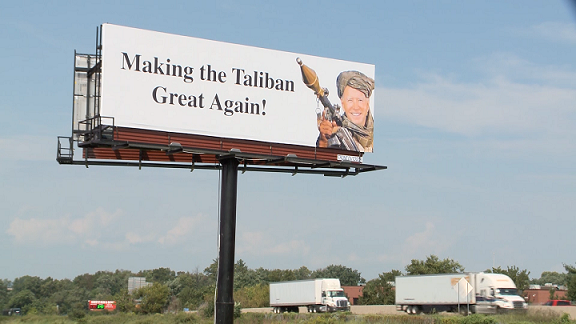Accelerating Extremism: Far-Right Stickers and Billboards
Storming of the US Capitol (January 6, 2021). Photo: Tyler Merbler via Wikimedia Commons.
Over Thanksgiving weekend I was making the trek from northern Virginia to New York State’s Capital Region and back. I took two different routes, mainly to avoid tolls on the return trip. On the way back to Virginia, I came across a number of stickers and billboards featuring several unsettling far-right symbols. My investigation into each of them was disturbingly easy; a simple Google search resulted in pages of far-right online content. Although the movement is increasingly based online, the lived consequences are severe. Each of the symbols I witnessed is a tiny signal of the movement’s very serious threat to democracy.
Having grown up in northern New York, I was not unfamiliar with these sorts of images. My concern over the far right has actually been developing for years, but the shock value of these sorts of messages never wears off. I turned 18 in 2017, just months after Donald Trump was inaugurated. I spent most of my college years under his “administration,” something that could just as easily be described as a “regime” (and would be if the United States were located in the Global South). During my final year of undergraduate school, I wrote a year-long thesis on the far right in my hometown community and found the movement was mostly hidden just under the surface of NNY society.
An accelerating movement
What I used to refer to as the emerging far right can be better described now as the malignant far right. While this movement has deep historical roots, its symbols have been circulated more broadly and openly in recent years. It is difficult to identify a single tipping point when they became so normalized in our lives. However, I began writing this article on January 6, 2022 - the one-year anniversary of the insurrection led by the now twice-impeached, former President.
Since Joe Biden’s election in 2020 and his inauguration in the weeks following the insurrection, there’s been a “back-to-normal” attitude permeating political life. This view thrives on the idea that elections are the ultimate protection against undemocratic forces. Such an attitude, however, is merely a neoliberal illusion promoted by politicians like Biden himself. But normalcy is outdated, and elections are not foolproof. After all, the far right went from fringe, to emergent, to malignant in just two election cycles. Today, the far right constitutes a major threat to democracy itself.
Warning: offensive, far-right content below
The first set of far-right symbols that I encountered on my drive were several stickers in Union Township, Pennsylvania, on the back of a traffic sign just off of I-81. I took this picture from my vehicle.
Far-right stickers found off I-81 in Union Township, Pennsylvania, in November 2021.
Each of these stickers could easily constitute its own story, but when put together, they tell a more disturbing tale. Based on the appearance and content of the stickers, they were not placed all at once. Some stickers were faded and torn, suggesting that they have been there for years. The community tolerance of these stickers in a public space for such a lengthy duration indicates that this movement has been comfortably growing there for a while.
For the record, I do not condone visiting websites like those listed on the stickers as I do not want to direct internet traffic there. But to be honest, I visited them - momentarily - to verify whether they are active and whether they hosted far-right content.
The “No White Guilt” sticker appears fresh; it was the sticker that caught my eye when we stopped at the red light. The prominently placed sticker contains a website URL and more text reading “Serving White Wellbeing.” The sticker is obviously racist and arguably fascist. Only after the initial shock had worn off seconds later did I realize that it was accompanied by other equally troubling emblems.
The next sticker down is a fresh-looking image of a train donning the American flag accompanied by text reading, “All Aboard the Trump Train” - an obvious reference to the man whose far-right ideas inspired those who carried out the January 6 insurrection.
Far-right conspiracy theories
Below that is a vertically placed bumper sticker with an image of a coiled snake, with text reading “Live Free or Die,” and web addresses for Infowars and PrisonPlanet. The sticker is being sold for $2.99 on eBay; the seller calls it an “older style - now out of print.” Either the sticker was purchased from a retailer like eBay recently, or it was placed there long ago. The organizations named on the sticker are both connected with known far-right extremist and conspiracy theorist Alex Jones. He is better known for Infowars, but the PrisonPlanet address redirects to another page that also appears to be linked to Jones. It bears his name, image, and a film title: “Endgame: Blueprint for Global Enslavement.” The site is littered with conspiracy theories and far-right content.
Beside the “Live Free or Die” sticker is a circular yellow sticker with footprints that parodies the pandemic-era signs marking where to stand to maintain social distance. The text below the feet says, “Please Wait Here Until You Realize Your Government is Brainwashing You.” The image I took is blurry, but I made out enough words to find the sticker online so that I could verify what it said. I found the sticker on eBay for $1.99. It promotes conspiracy theories and misinformation about COVID-19, as well as the idea that the government is actively misleading the public about the pandemic.
The last sticker is a relic from the 2016 election. It is the classic “Hillary for Prison 2016” bumper sticker. About a third of the sticker is peeled away, but it is still easily recognizable. I can remember seeing this design on bumper stickers, lawn signs, t-shirts, etc., all around me during the 2016 campaign cycle. The state of this sticker - especially relative to the others - implies age. It could be years old, from around the time the far right felt like a fringe movement being ignited by the 2016 Trump campaign.
Former state senator sponsored billboards
On I-83 in York County, Pennsylvania, I witnessed another unsettling site. It reads “Making the Taliban Great Again” and features an image of President Biden in what I would describe as stereotypical Taliban garb. I was unable to take my own image, so the one provided below was found online.
“Making the Taliban Great Again” billboard in York County, Pennsylvania, in November, 2021. Source: ABC27 News
A Google search resulted in several articles about the billboard, which was apparently sponsored by former Pennsylvania State Senator and gubernatorial candidate Scott Wagner. He purchased twelve billboards in total.
The massive sign is referencing the military withdrawal from Afghanistan in the summer and fall of 2021, a decision that resulted in the near-immediate reignition of Taliban rule over the country. The withdrawal from Afghanistan was initiated by Trump and fulfilled by Biden. It was a political goal of each administration, and it has likewise been criticized on all sides.
Wagner’s divisive billboards adapted the former President’s infamous campaign slogan, “Make America Great Again” to criticize the current President. This particularly crude, far-right version of criticism demonstrates the intersection of the contemporary far right with the American Republican Party and with electoral politics more generally. As the far right accelerates, especially within the Republican Party, it becomes more difficult to differentiate between the provocative extremist and the acquiescent moderate.
Gas pump guerilla campaign
The third symbol that I found during my drive was placed on gas pumps at a station in Thurmont, Maryland. At that moment, I thought very little of it - I did not look closely at the stickers. For this reason, the image below was also found through an online search.
“I Did That!” Gas pump sticker campaign in Thurmont, Maryland, in November 2021. Source: Custom Sticker Shop
The sticker is an image of Biden pointing toward the price on the gas pump and saying “I DID THAT!” The stickers are referencing the recent rise in gas prices across the country, a development that has a complex set of causes globally but that has nonetheless provided conservatives with an opening to fuel popular anger at the President.
The Boston Herald called the stickers a “Republican guerrilla campaign'' and noted, “This is what passes for grass roots political strategy these days. The ‘Let’s Go Brandon’ chant and ‘I Did It’ stickers went viral on social media platforms like TikTok.” The stickers are sold by online retailers including Amazon, Etsy, and eBay. The easily accessible and cheap medium reaches anyone who pumps their own gas. When combined with the campaign’s viral online presence, the stickers demonstrate how far-right imagery has been normalized both in our physical lives and online communities.
Normalizing extremism
Pennsylvania, like most other states, has a number of hate groups operating there. The Southern Poverty Law Center tracked 838 hate groups in 2020, 36 of which were active in Pennsylvania. Of those, 15 operated statewide.The organization’s ‘Year in Hate and Extremism’ report described a “broader but more loosely affiliated movement of far-right extremists who reject the country’s democratic institutions and pluralistic society.” PennLive Patriot-News called Pennsylvania a “hotbed for hate groups” and describes the normalization of far-right ideologies across the Commonwealth. The report mentions factors like the geopolitical and political climate, economic conditions, the coronavirus pandemic, joblessness, and racism towards Asian Americans as contributing to the recent rise in far-right activity.
The crisis in rural America has only gotten worse in recent years. Organizing Upgrade, a “political project in support of the movements for multi-racial democracy,” published an article that described a small southeastern Pennsylvania town where far-right extremists took center-stage in a school board vote on mask requirements. The author described her community as one where “People know what it’s like to struggle to keep food on the table, and a roof over their heads. Most feel like they don’t have time for politics. Besides, they feel left behind in the economy, and abandoned by the government.” She says, “The only people offering hope were far-right extremists.” The conditions in her community reflect the crisis in many rural spaces across the country. The anti-democratic ideology of these groups and movements is the violent expression of crisis-induced pain.




